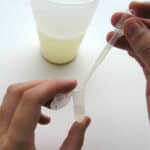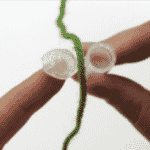Overview
STEM careers
Time
Materials
For Advance Preparation:
|
Per Whole Group of 20 Participants:
|
Instructions
ADVANCE PREPARATION:
Several hours before the activity: Put the ice pack in the freezer and the alcohol in the refrigerator.
At least 30 minutes before the activity: Create the wheat germ liquid and the dropper bottle of alcohol. For the wheat germ liquid:
- Add 1⁄2 cup hot water to a cup.
- Add 1 spoon of wheat germ to the cup of hot water.
- Add 1⁄2 spoon of meat tenderizer to the cup.
- Add a squirt (about a teaspoon) of shampoo.
- Stir well.
- Let mixture settle for 15 minutes.
For the dropper bottle of alcohol:
- Fill the dropper bottle with chilled alcohol.
- Place the ice pack in the small plastic bin.
- Keep the dropper bottle on the ice pack during the activity.
Caution: For safety, be sure to inform participants not to taste or eat any of the materials during this activity.
ACTIVITY:
- Offer a description of DNA appropriate for your participants.
- Ask students if they know what DNA looks like and if they have ever seen DNA?
- Explain that today they are going to get the chance to separate and see the DNA of wheat germ. They will even create jewelry out of it.

- Tell students that wheat germ is the top part of the wheat plant that makes new plants (consider showing students a picture to illustrate).
- Explain what the activity entails and the materials involved.
- Provide these instructions:
- Use a pipette to fill a plastic tube halfway with wheat germ liquid.
- Use the dropper bottle to add alcohol to the tube; fill the tube almost to the top.
- Snap the lid shut and gently rock the tube a few times.
- Open the lid, put a piece of yarn over the edge of the cap, and snap the lid shut in order to secure the tube on the yarn.
- Tie the yarn to create a DNA necklace.


Guiding questions
-
After you’ve rocked the tube back and forth a few times, what do you see?
-
This DNA comes from wheat germ. Do you think our own DNA looks like this? Why or why not?
-
Do you think the DNA will look the same in your necklace after a week? Why or why not?
Engineering & science connections
- DNA (or deoxyribonucleic acid) is the main genetic material inside the cells of every living thing. It provides the instructions to cells on how to grow and do their jobs. If you were able to unwrap all the DNA molecules in all your cells you would be able to stretch it to the moon and back 3,000 times.
- You are more closely related to those around you than you think: Every human being shares 99% of the same exact DNA code with all other human beings, and 99.5% of their DNA with their parent or child.
- Synthetic biology is an area of research that combines biology and engineering. Synthetic biologists use scientific information about DNA and the structure of organisms to build new living organisms and materials. For example, synthetic biologists have created artificial photosynthesis systems to convert carbon dioxide to oxygen and even to other products.
- Some potential uses for synthetic biology come straight out of science fiction:
- Terraforming: One day, synthetic biology could allow us to terraform—or make livable—planets like Mars that are now unable to support life.
- Genetic manipulation: The most controversial application of synthetic biology is in modifying the genes of human embryos to cure genetic diseases before a child is born. There has only been one attempt to do this with a human embryo—in China— and it led to a large number of unwanted mutations. This shows that there is still a lot to learn about how our DNA works.
This activity was developed by the Sciencenter, Ithaca, NY. This material is based upon work supported by the National Science Foundation under Grant Number DRL 1421179. Any opinions, findings, and conclusions expressed in this material are those of the authors and do not necessarily reflect the views of the National Science Foundation.


0 Comments